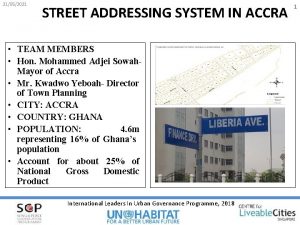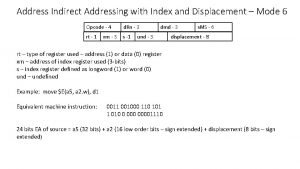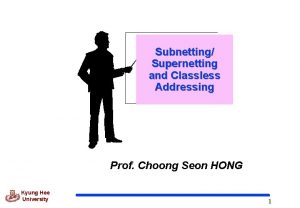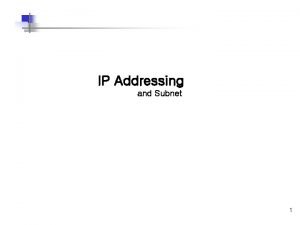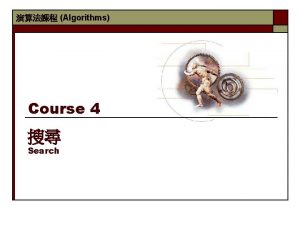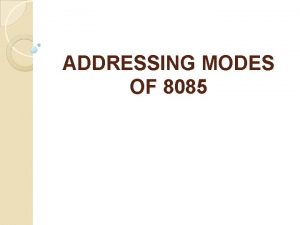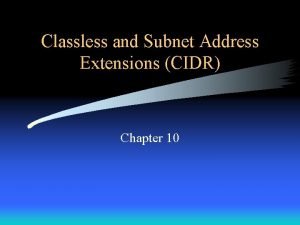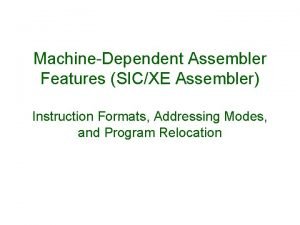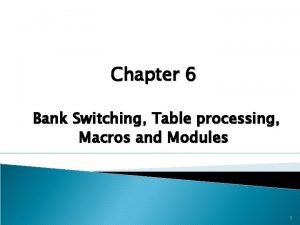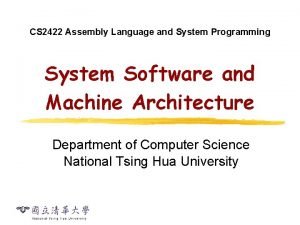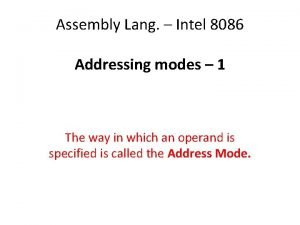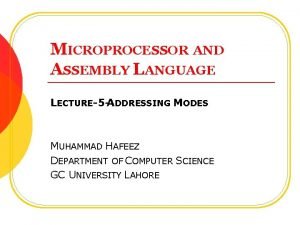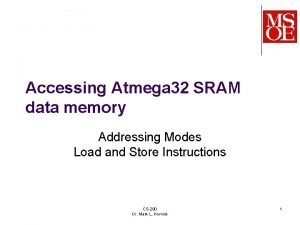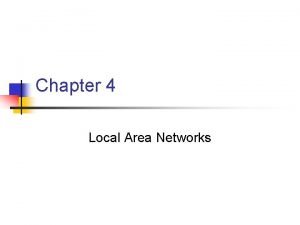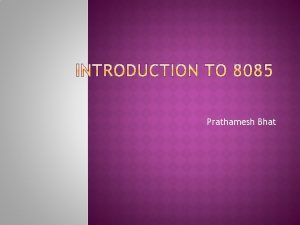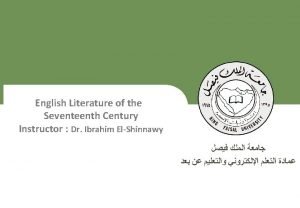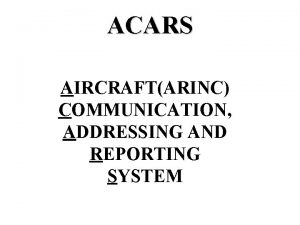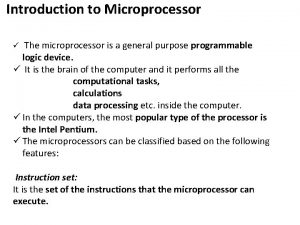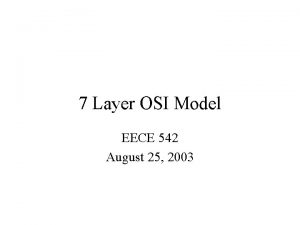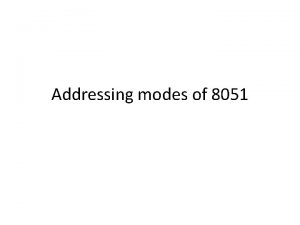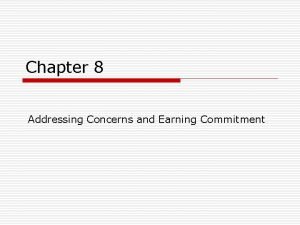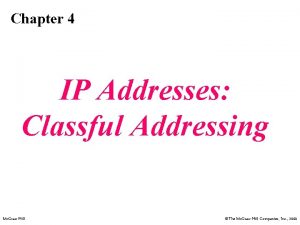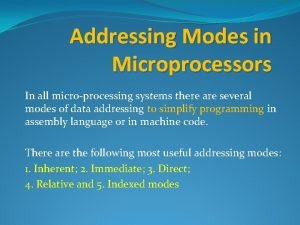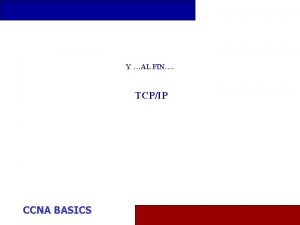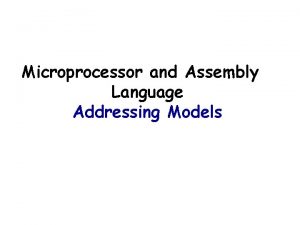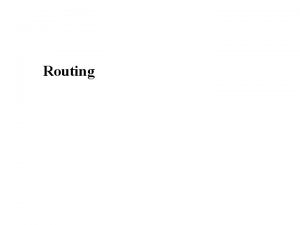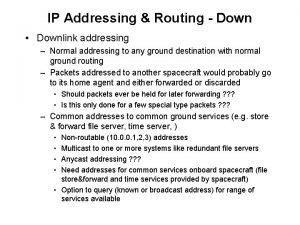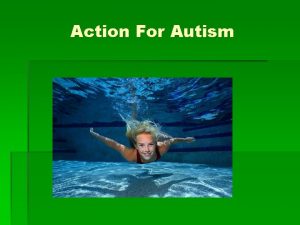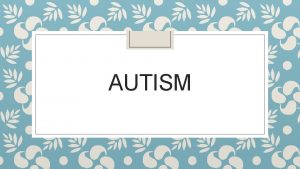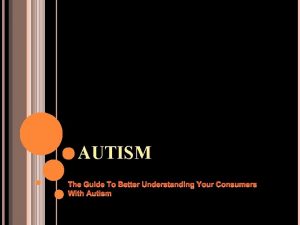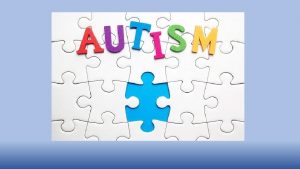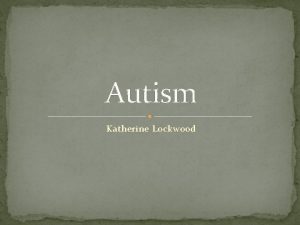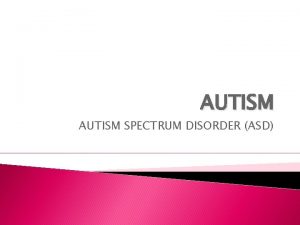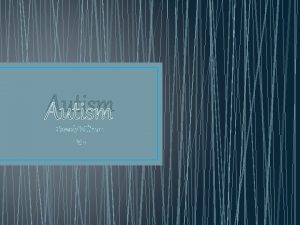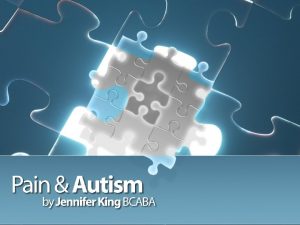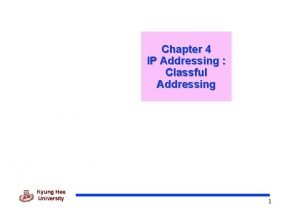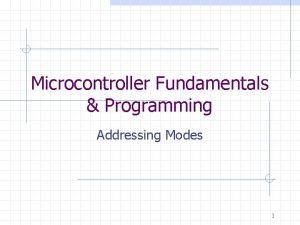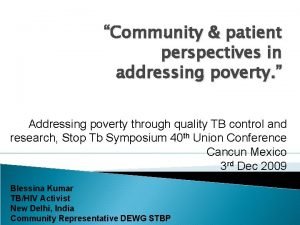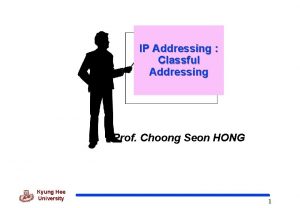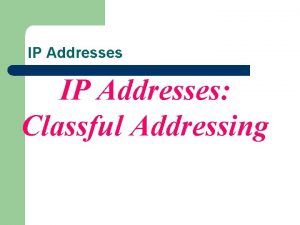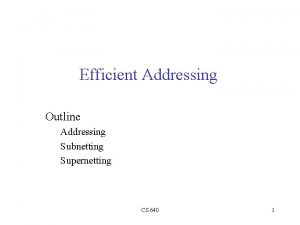Addressing Autism What is Autism Autism is a


































- Slides: 34

Addressing Autism

What is Autism? Autism is a lifelong condition. Autistic Spectrum disorders. People with autism have difficulties with communication, social understanding, flexibility, sensory issues. ( Wing, L. 1979, Bogdashina, O. 2003) Delays rather than deficits.

Communication Spontaneous communication (Potter and Whittaker) Facilitated communication Receptive Language Non verbal language Literal understanding and idiom (Blackburn) Processing time

PECS and Pyramid • Stages of PECS • PECS across the day • Innovative uses of PECS

Oak View communication • Develop augmentative communication (e. g. Picture Exchange Communication System; Frost and Bondi 2002) • Include speech and language targets in the classroom • Use of Makaton, objects of reference, photographs and simple speech cues for those students who need other approaches • Include communication targets in students’ IEPs • View challenging behaviours as communicative • Find more appropriate ways to communicate needs to reduce challenging behaviours • Intensive interaction (Hewett and Nind 1998)

Options in mainstream Written info Laptop Symbols in filofax style books Expect literal understanding Allow processing time The role of the 1 : 1 could be as interpreter – to collate a phrase book for the neurotypical world To repair misunderstandings and to facilitate processing time

It’s not just how they communicate with us. . .

It’s how we communicate with them



First we watch. .

. . and then we do

Social Understanding Students with autism do not pick up social cues Every thing must be explicitly taught Again, and again ( Blackburn 2008) Other people seem illogical and unpredictable Inability to share a theory of mind impairs empathic response (Mitchell 1996) Don’t teach social skills at the same time as other skills Provide visual cues/ back up What do we know about social skills. . Eating dinner


Oak View School Social understanding • • • Intensive interaction PECS : initiation/communication between students Socialeyes Learn social skills specifically and not alongside other activities Use play to develop theory of mind (Sherrat 2000) Social stories and comic strip conversations Carol Gray Limited use of modelling Rules of interaction : openers/ closers ( activity )

Options in mainstream Support staff can write social stories Explain each social rule and don’t expect them to by , caught / immediately understood Unstructured and social times could be the hardest – think about staff allocation – is playtime a better time to have extra support, than maths Facilitate withdrawal Where a teacher is using a whiteboard presentation could these be made available to students, through laptops to avid aversive group time Teach being in a groups – at a different time from academic skills / knowledge Allocate peer mentors Train students in ASD understanding

Flexibility of Thought Students with autism can find it really difficult to make sense of the world around them Predictability can help Schedules, structure, routine Prosthetic environment Build in changes ( surprise cards ) Using imaginative play/ drama. What is the pivotal part of the day ?


Oak View School and flexibility • Introduce TEACCH style approaches, trained staff • All students with autism have a schedule • Clear structure and routine based days to make students secure enough to learn to deviate from the routine • Warn students about changes in routines, practice being flexible e. g. fire drills • Prepare students for breaks and holidays • Don’t make assumptions about the pivotal part of the day • Develop imaginative play to facilitate further flexibility

TEACCH Why use structure in the classroom? It helps the child with autism to understand It helps children with autism to be calm It helps children with autism to learn better Structure is the prosthetic device that will help the child with autism to achieve independence

Work bay Life skills


Options in mainstream Schedules for whole classes can be beneficial Can be diaries, phone, ipod, ipad, laptop or filofax based Most students will always need the schedule – celebrate using it as a tool towards independence rather than trying to work away from it –the equivalent of a hearing aid etc Support staff can set up schedules, teach ownership, teach students to manage their own schedules

Sensory Issues • Students with autism can be under stimulated or over stimulated in any of the following; in any combination, and it can change. . . • Vision • Hearing • Taste • Smell • Touch • Vestibular : balance • Propriorceptive : body in space • Gestalt perception • (Bogdashina, O. 2003)

Oak View School and Sensory issues Began staff training and encouraged further reading Began sensory profiling of students (Bogdashina 2003) Wrote a policy Tried to ensure that students were not over or under stimulated • Considered sensory issues to be major cause of challenging behaviours. • Endeavoured to reduce these behaviours by addressing sensory issues • Pursue sensory integration • •

Options in mainstream Withdrawal spaces – tents/ library Withdrawal tools – headphones / dark glasses/ scarves/ scented hankies/ strong flavours/ modified uniforms/ backpacks/ body warmers / flexibility with uniform Access to sensory integration style activities – could be as simple as getting a turn on playground equipment every day/ big balls to sit on/ rockers on chairs – or could be a comprehensive professional program

Behaviour • There is no such thing as an autistic behaviour (Blackburn 2008) • View behaviour as communicative ( Clements 2005) • Record, record • And then assess, assess • Be a detective • Keep records across the year • Let me tell you a secret. . . The behaviours tend to stay in the young persons repertoire.

Oak View School and Behaviour View all behaviours as communicative Record all behaviours Consider and the whats, whens, hows and whys. Analyse patterns of behaviour Give students more appropriate equivalents to meet the same needs • Consider behaviours as contextually inappropriate, rather than inappropriate. • Take the responsibility to prevent rather than relying on reacting to behaviours that have happened. • • •

Think of pupils in your school… Consider the pupil’s communication • What are they understanding and what are they missing? • How are they helped? • Do they have augmentative communication systems in place? • Do they have schedules, routines, predictability, filofax, diary, calendar, ipod, ipad, laptop, phone? • Have the relevant social rules been explained to them? • Are their sensory needs being met, do you know what they are? Are they fluctuating?

Thinking And Learning People with autism have difficulties with • Metataxis : holding 2 perspectives at once (Sherrat and Peter 1998) • Weak central coherence : ability to process minutiae in detail, difficulties in understanding the context as a whole leads to extra abilities and extreme difficulties in processing and learning (Frith 1989) • Theory of mind ( Leslie and Frith 1988) • Difficulty working independently, coping with interaction and the task at the same time. Copyright Luci Rose Oak View School 2011

Oak View School Thinking and Learning We acknowledge that students with autism think and learn in different ways and that it is our responsibility to modify the methods and resources with use : • • Present information visually Learn one concept at a time Plan for generalisation Plan for problem solving Plan for interaction and co-operation Plan for independent work Plan for choice making Demonstrate what outcome is expected , clear beginnings and endings of activities.

References Wing, L. 1979; National Autistic Society website www. nas. org. uk 2008; Bogdashina, O. “Sensory Perceptions Issues in Autism and Asperger Syndrome” 2003. Potter, C. and Whittaker, C. 2001 Enabling Communication “A picture’s worth” Frost, L and Bondi, A. 2002. “Interaction in action” Hewett , D. and Nind, M. 1998. Mitchell, P “Theory of Mind and Autism” 1996 “Logically Illogical” a talk by Ros Blackburn 2008 Bogdashina, O. “Sensory Perceptual Issues in Autism and Asperger Syndrome”. 2003. “Developing Play and Drama in Children with Autistic Spectrum Disorders” Sherrat , D. and Peter, M. 1998. “Autism Explaining the Enigma” Frith, U. 1989.

Training ideas Area Training Communication PECS (Pyramid Education) Intensive interaction (Dave Hewett) Social Understanding Social Stories and Comic Strip Conversations Carol Gray (Gray Centre) NAS Social eyes NAS website Flexibility TEACCH/ Pyramid Sensory Issues Olga Bogdashina Challenging Behaviour John Clements Sexual Issues and Autism Luke Beardon (NAS/ Sheffield University) Jenny Coffee Further understanding including thinking and learning Birmingham University distance/ part time courses. Autism Centre Sheffield Hallam University All of the above Oak View School Training Autumn Term 2011 TBC

Activities Communication Social understanding Sensory Issues Flexibility Structured teaching One student One class Whole school : school development plan Accreditation
 Flat addressing vs hierarchical addressing
Flat addressing vs hierarchical addressing Street addressing system
Street addressing system Displacement addressing mode
Displacement addressing mode Subnetting supernetting and classless addressing
Subnetting supernetting and classless addressing Classful ip addressing
Classful ip addressing 서브넷
서브넷 Linear open addressing
Linear open addressing Addressing modes of 8085 microprocessor
Addressing modes of 8085 microprocessor Addressing dyslexia toolkit
Addressing dyslexia toolkit Classless subnetting
Classless subnetting 00001000
00001000 Xbpe
Xbpe Movlw 0x56 is an example of which addressing mode
Movlw 0x56 is an example of which addressing mode Sic programming examples
Sic programming examples Based addressing mode in 8086
Based addressing mode in 8086 Microprocessor
Microprocessor Data memory of atmega32
Data memory of atmega32 Classful addressing table
Classful addressing table Mac addressing
Mac addressing Addressing mode of the following instruction. lxi sp, c200h
Addressing mode of the following instruction. lxi sp, c200h To daffodils by robert herrick theme
To daffodils by robert herrick theme What is acars system
What is acars system Direct address table vs hashtable
Direct address table vs hashtable Register organization of 8086
Register organization of 8086 Tcp ip osi
Tcp ip osi Addressing modes of 8051
Addressing modes of 8051 Absolute addressing mode in computer architecture
Absolute addressing mode in computer architecture Earning commitment
Earning commitment Addressing modes
Addressing modes Class b ip address example
Class b ip address example Classful addressing example
Classful addressing example Define addressing mode
Define addressing mode Automatic private ip addressing
Automatic private ip addressing Protected mode memory addressing
Protected mode memory addressing Sic instruction set
Sic instruction set

